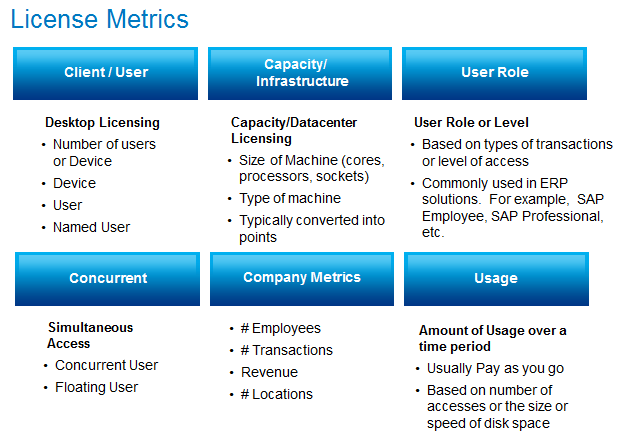This blog is part 1 of a series that will cover all of the common software license models in use today and the license management challenges presented by each type. Software asset management (SAM) and Software License Optimization tools must have the breadth to manage all of these license models and meet these challenges.
Software vendors (ISVs) use a multitude of different license models and metrics to quantify license consumption and generate revenue for their products. Each software vendor has different terminology for what they call their metric, but there are a finite number of ways to count licenses. Understanding each metric at a broad level will help you to lay a foundation to understand licensing from any publisher.
Licensing models fall into six general categories regardless of the software vendor:
Many software vendors cross the spectrum of license metrics in an attempt to maximize the revenue for their portfolio of software products. For example, IBM sells capacity, client/user, concurrent, company metrics, and usage based licenses. In addition, any given product may be sold under multiple license metrics. Microsoft SQL Server can be purchased by Client or Capacity license models and IBM Websphere can be purchased by Capacity or Company Metrics license models, for example.
The actual metric purchased by the customer is designated in the stock keeping unit (SKU)/Manufacturer part number – each product/license model combination has a different SKU number.
There can also be subtle combinations of license metrics within the same SKU. For example, SQL Server can be purchased under a combination Client + Processor model. Accurately determining which license model to buy is a material decision for any company. Acquiring products under the wrong/not optimal metric can be a very costly mistake.
IT Asset Management
It all starts with knowing what’s in your IT ecosystem. Flexera One discovers even the most elusive assets whether on-prem, SaaS, cloud, containers and more.
Its critically important for Software License Optimization tools to manage all categories of license models so that organizations have the visibility they need to negotiate software contract renewals and can easily be prepared for annual true-ups and software license audits. License metrics such as Capacity and Concurrent models are impossible to manage without an automated solution.
As discussed in a few previous blogs (SKU library: A key differentiator between Software Asset Management tools, and Why a SKU is important to Software License Optimization), a SKU library can streamline the license reconciliation process. The SKU can be used to automatically apply the correct license model based on the software part number purchased.
In the next blog in this series, we’ll delve into the details on the Client/User license model.






